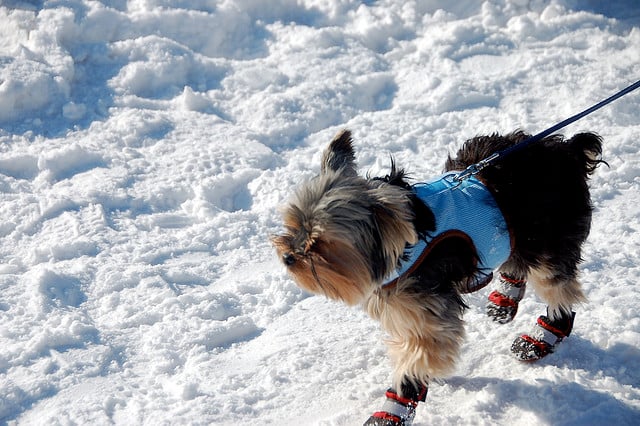For many dogs, clothes are the only way to keep warm in winter. Small dog breeds, pets with short or thin coats, puppies, senior dogs, and pets with immune disorders need an extra layer when the temperature starts to drop. On the opposite end of the spectrum, large pets and those with thick fur should probably not wear dog clothes. Many breeds of dog – typically sled dog breeds – are designed to endure winter, like Malamutes, Akitas and Bernese Mountain Dogs, so they would be uncomfortable in an extra layer.
We asked our Facebook community – do you dress up your pup for the winter? Of the answers, 64% said “YES, of course their pet wears pet clothing or a rain jacket!” while a third – 33% – said nope, no way. For those that said yes, we’ve got some ideas for you!
Your pup doesn’t need a whole winter wardrobe, but there are a few essentials for cold days. Two things to remember when you bring out the sweater-clad pup: (1) When it’s below freezing, limit your dog’s outdoors time to under half an hour. No matter what they’re wearing. And (2) if your pup loves romping around in the wintery wonderland for longer than that, you can provide a heated or insulated dog house as refuge.
Dog Snow Boots

For wintertime walks, dog boots are essential! De-icing chemicals like calcium and sodium chloride can burn pets’ paws. Usually referred to as “rock salt,” the substance causes a chemical reaction that generates heat, irritating sensitive paw pads. Dogs are also at risk of licking off the salt, leading to dermatitis or burns around the mouth and severe gastrointestinal issues like vomiting.
When picking out winter dog boots, be sure to check the size chart. Fit is all-important – too-loose boots may let in snow and salt, soaking paws – so be sure your pup can actually walk in his winter boots. If they’re too tight, chafing or pinched paws can occur. Dog clothes can be awkward to wear at first, so get Fido used to footwear by having him wear them around the house first.
Try these dog snow boots: Ruffwear “Summit Trex” dog boots, Guardian Gear All Weather Dog Boots
Dog Sweaters

If you find your pet shivering or curling up fireside all day, a dog sweater may be in order. Contrary to popular belief, it’s not the size of the dog that matters, but how thick their fur is. Pups with thin or short fur, like Beagles and Great Danes, have less insulation than a Malamute or even a Labrador. Hair length doesn’t always translate to warmth; Maltese and Shih Tzus may have luxurious locks, but they lack a dense undercoat. Furthermore, some dogs have trouble regulating their body temperature. Senior dogs, puppies, and pets with diseases like diabetes and Cushing’s may require dog clothes to stay toasty.
If you notice your pup pawing at a sweater or seeming uncomfortable, take it off! Many kinds of material can be irritating to dogs’ skin – such as wool – so choose a fabric blend that’s comfortable and cozy. Avoid dog sweaters with small, chewable parts like zippers and buttons; these can be ingested and cause an intestinal obstruction.
Try these dog sweaters: Chilly Dog sweaters, Anima dog sweaters
Waterproof Dog Vest

Keeping your pet’s belly dry is key to maintaining warmth during winter outings. Snow and ice can quickly drench small dogs like Corgis and Dachshunds, making a waterproof dog vest or jacket essential. Wet fur may even freeze if the temperature is low enough, putting pups at risk of hypothermia or frostbite. Large dogs with thin or no fur on their abdomens may also require a waterproof dog vest – again, it’s the thickness of the fur, not the size of the dog!
Make sure any dog clothes do not restrict movement, especially under pets’ legs. Never put your dog back into a wet jacket or sweater; putting on a damp garment can do more harm than good, cooling your pet’s body temperature or even freezing to the fur.
Try these waterproof dog vests: Kurgo “North Country” dog coat, Barbour Waxed-Cotton Dog Jacket
Dog Coats for Winter

For longer periods spent outdoors, a winter dog coat may be needed. Many winter dog coats are lined with real or synthetic fleece, providing an extra layer of warmth when compared to a waterproof dog vest. Look for dog clothes that protect exposed, sensitive areas: the neck, underbelly and chest. Some pups will tolerate dog coats with hoods, while others absolutely refuse to wear them.
Pets with little body fat or thin fur, such as Greyhounds, get cold easily. However, for intense exercise like running, dog clothes can get in the way or even cause a dog to overheat. Always pay attention to how your pet is behaving. Shivering? Coat, please! Panting excessively? Take it off. The most important thing is that your pet is comfortable. After all, isn’t that the point of dog clothes? Be sure to select high-quality materials that dry quickly and are cozy for winter weather.
Try these dog coats for winter: Ruffwear “Powder Hound,” Hurta “Pro” Winter Jacket
(Title photo via Flickr.com/ynakanishi)








